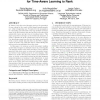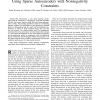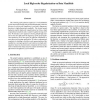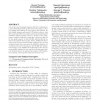CORR
2016
Springer
9 years 9 months ago
2016
Springer
In Twitter, and other microblogging services, the generation of new content by the crowd is often biased towards immediacy: what is happening now. Prompted by the propagation of c...
CORR
2016
Springer
9 years 9 months ago
2016
Springer
CORR
2016
Springer
9 years 9 months ago
2016
Springer
We provide the first experimental results on non-synthetic datasets for the quasidiagonal Riemannian gradient descents for neural networks introduced in [Oll15]. These include th...
CORR
2016
Springer
9 years 9 months ago
2016
Springer
Abstract. We give an algorithm for computing approximate PSD factorizations of nonnegative matrices. The running time of the algorithm is polynomial in the dimensions of the input ...
104
click to vote
CORR
2016
Springer
9 years 9 months ago
2016
Springer
Abstract—We demonstrate a new deep learning autoencoder network, trained by a nonnegativity constraint algorithm (NCAE), that learns features which show part-based representation...
CORR
2016
Springer
9 years 9 months ago
2016
Springer
In this paper, a robust adaptive type-2 fuzzy nonsingular sliding mode controller is designed to stabilize the unstable periodic orbits of uncertain perturbed chaotic system with ...
CORR
2016
Springer
9 years 9 months ago
2016
Springer
Ensuring privacy of users of social networks is probably an unsolvable conundrum. At the same time, an informed use of the existing privacy options by the social network participa...
CORR
2016
Springer
9 years 9 months ago
2016
Springer
The common graph Laplacian regularizer is well-established in semi-supervised learning and spectral dimensionality reduction. However, as a first-order regularizer, it can lead to...
CORR
2016
Springer
9 years 9 months ago
2016
Springer
One of the most discussed features offered by Informationcentric Networking (ICN) architectures is the ability to support packet-level caching at every node in the network. By in...
CORR
2016
Springer
9 years 9 months ago
2016
Springer
Algorithms that generate computer game content require game design knowledge. We present an approach to automatically learn game design knowledge for level design from gameplay vi...




